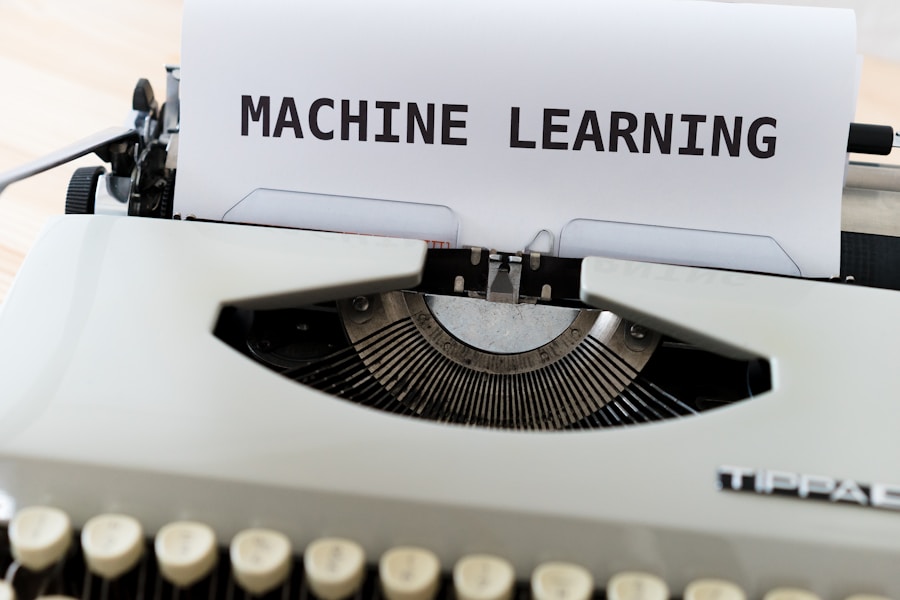Artificial Intelligence (AI) has emerged as one of the most transformative technologies of the 21st century, fundamentally altering how we interact with machines and process information. At its core, AI refers to the simulation of human intelligence in machines programmed to think and learn like humans. This encompasses a wide range of technologies, from simple algorithms that perform specific tasks to complex systems capable of understanding natural language and recognizing images.
Deep learning, a subset of machine learning, has gained particular prominence due to its ability to analyze vast amounts of data and identify patterns with remarkable accuracy. By utilizing neural networks that mimic the human brain’s architecture, deep learning enables machines to perform tasks such as image recognition, speech processing, and even autonomous driving. The rapid advancement of AI and deep learning technologies has been fueled by the exponential growth of data generated in our digital age.
With the proliferation of the internet, smartphones, and IoT devices, vast quantities of structured and unstructured data are available for analysis. This data serves as the foundation for training deep learning models, allowing them to improve their performance over time. As a result, industries across the globe are increasingly adopting AI-driven solutions to enhance efficiency, reduce costs, and create innovative products and services.
The convergence of AI and deep learning is not merely a technological trend; it represents a paradigm shift that is reshaping our world in profound ways.
Key Takeaways
- AI and deep learning are revolutionizing industries by enabling machines to learn from data and perform tasks that typically require human intelligence.
- The impact of AI and deep learning on industries is significant, with advancements in automation, predictive analytics, and personalized customer experiences.
- The future of AI and deep learning holds promise for continued innovation and integration into various sectors, leading to increased efficiency and productivity.
- Ethical implications of AI and deep learning include concerns about privacy, bias in algorithms, and the potential for job displacement.
- AI and deep learning play a crucial role in healthcare by improving diagnostics, drug discovery, and personalized treatment plans.
The Impact of AI and Deep Learning on Industries
The influence of AI and deep learning extends across various sectors, revolutionizing traditional practices and introducing new methodologies. In manufacturing, for instance, AI-powered robots are streamlining production lines by performing repetitive tasks with precision and speed. These intelligent machines can adapt to changes in their environment, learn from their experiences, and even predict equipment failures before they occur.
This predictive maintenance capability not only minimizes downtime but also significantly reduces operational costs. Companies like Siemens and General Electric are at the forefront of integrating AI into their manufacturing processes, showcasing how these technologies can enhance productivity and quality. In the realm of retail, AI and deep learning are transforming customer experiences through personalized recommendations and inventory management.
E-commerce giants like Amazon leverage sophisticated algorithms to analyze consumer behavior, enabling them to suggest products tailored to individual preferences. This level of personalization not only boosts sales but also fosters customer loyalty. Additionally, AI-driven analytics help retailers optimize their supply chains by predicting demand fluctuations and managing stock levels more effectively.
The ability to analyze vast datasets in real-time allows businesses to respond swiftly to market changes, ensuring they remain competitive in an ever-evolving landscape.
The Future of AI and Deep Learning

Looking ahead, the future of AI and deep learning appears both promising and complex. As technology continues to evolve, we can expect even more sophisticated applications that will further integrate into our daily lives. One area poised for significant growth is natural language processing (NLP), which enables machines to understand and generate human language.
Advances in NLP could lead to more intuitive virtual assistants capable of engaging in meaningful conversations, thereby enhancing user experiences across various platforms. Companies like OpenAI are already making strides in this field with models like GPT-3, which can generate human-like text based on prompts. Moreover, the integration of AI with other emerging technologies such as quantum computing holds immense potential.
Quantum computing could exponentially increase the processing power available for training deep learning models, allowing for more complex simulations and analyses that were previously unattainable. This convergence could lead to breakthroughs in fields such as drug discovery, climate modeling, and materials science. However, as we embrace these advancements, it is crucial to consider the implications they may have on society, including job displacement and the need for reskilling the workforce.
The Ethical Implications of AI and Deep Learning
| Topic | Data/Metrics |
|---|---|
| AI Bias | Percentage of biased algorithms identified in AI systems |
| Privacy Concerns | Number of data breaches involving AI and deep learning technologies |
| Job Displacement | Percentage of jobs at risk of automation due to AI and deep learning |
| Algorithmic Accountability | Number of cases where AI decision-making processes have been questioned |
| Ethical Decision-making | Percentage of organizations implementing ethical guidelines for AI development and deployment |
As AI and deep learning technologies become increasingly pervasive, ethical considerations surrounding their use have come to the forefront of public discourse. One major concern is the potential for bias in AI algorithms, which can lead to discriminatory outcomes in areas such as hiring practices or law enforcement. If the data used to train these models reflects historical biases or societal inequalities, the resulting algorithms may perpetuate these issues rather than mitigate them.
For instance, facial recognition systems have been criticized for exhibiting racial bias, leading to calls for greater transparency and accountability in AI development. Another ethical dilemma involves privacy concerns related to data collection and usage. As organizations harness vast amounts of personal data to train their AI systems, questions arise about consent and ownership.
Individuals may not fully understand how their data is being utilized or the implications of its use in decision-making processes. Striking a balance between innovation and privacy protection is essential to ensure that technological advancements do not come at the expense of individual rights. Policymakers and technologists must collaborate to establish frameworks that promote ethical AI practices while fostering innovation.
The Role of AI and Deep Learning in Healthcare
In healthcare, AI and deep learning are revolutionizing diagnostics, treatment planning, and patient care management. Machine learning algorithms can analyze medical images with remarkable accuracy, assisting radiologists in detecting conditions such as tumors or fractures that may be missed by the human eye. For example, Google’s DeepMind has developed an AI system capable of diagnosing eye diseases from retinal scans with a level of precision comparable to that of expert ophthalmologists.
This capability not only enhances diagnostic accuracy but also expedites the treatment process, ultimately improving patient outcomes. Furthermore, AI-driven predictive analytics are transforming patient care by enabling healthcare providers to anticipate patient needs proactively. By analyzing electronic health records (EHRs) and other data sources, machine learning models can identify patients at risk for certain conditions or complications, allowing for timely interventions.
For instance, hospitals are using AI algorithms to predict patient readmissions based on historical data, enabling them to implement targeted strategies that reduce readmission rates. As these technologies continue to evolve, they hold the potential to create a more personalized approach to healthcare that prioritizes prevention and early intervention.
Advancements in AI and Deep Learning Technology

Transfer Learning: Adapting Models for New Tasks
One notable development is the emergence of transfer learning, a technique that allows models trained on one task to be adapted for another with minimal additional training data. This approach significantly reduces the time and resources required for model development while enhancing performance across various applications. For instance, a model trained on a large dataset for image classification can be fine-tuned for a specific medical imaging task with relatively few labeled examples.
Generative Adversarial Networks (GANs): Unlocking Creativity
Another significant advancement is the rise of generative adversarial networks (GANs), which have opened new avenues for creativity in fields such as art and design. GANs consist of two neural networks—a generator that creates new data samples and a discriminator that evaluates their authenticity—working in tandem to produce realistic outputs.
Applications and Future Innovations
This technology has been employed in various applications, from generating lifelike images to creating synthetic data for training other models when real data is scarce or sensitive. As these technologies mature, they will likely lead to innovative solutions across diverse domains.
The Influence of AI and Deep Learning in Finance and Business
In finance, AI and deep learning are reshaping how institutions manage risk, detect fraud, and make investment decisions. Machine learning algorithms can analyze vast datasets in real-time to identify patterns indicative of fraudulent activity, enabling financial institutions to respond swiftly to potential threats. For example, companies like PayPal utilize AI-driven systems that monitor transactions for unusual behavior patterns, significantly reducing losses due to fraud while enhancing customer trust.
Moreover, algorithmic trading powered by deep learning has transformed investment strategies by enabling firms to execute trades at lightning speed based on real-time market analysis. These algorithms can process news articles, social media sentiment, and historical price data to make informed trading decisions within milliseconds. As a result, firms leveraging these technologies can gain a competitive edge in an increasingly volatile market environment.
However, this reliance on automated systems also raises concerns about market stability and the potential for unforeseen consequences during periods of high volatility.
The Challenges and Opportunities of AI and Deep Learning
Despite the myriad opportunities presented by AI and deep learning technologies, several challenges must be addressed to fully realize their potential. One significant hurdle is the need for high-quality data; without accurate and representative datasets, machine learning models may produce unreliable results. Organizations must invest in data governance practices that ensure data integrity while also addressing issues related to privacy and security.
Additionally, there is a pressing need for skilled professionals who can develop and implement AI solutions effectively. The demand for data scientists, machine learning engineers, and AI ethicists is rapidly outpacing supply, leading to a talent gap that could hinder progress in the field. Educational institutions must adapt their curricula to equip students with the necessary skills while fostering interdisciplinary collaboration between technology experts and domain specialists.
As we navigate these challenges, it is essential to recognize that the evolution of AI and deep learning presents unprecedented opportunities for innovation across various sectors. By embracing these technologies responsibly and ethically, organizations can unlock new levels of efficiency, creativity, and problem-solving capabilities that will shape our future in profound ways.












Leave a Reply